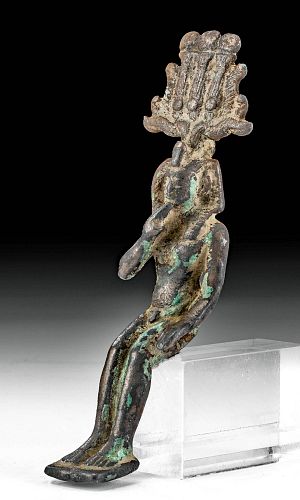Fine Egyptian Bronze Seated Harpokrates
Lot 2
About Seller
Artemis Fine Arts
686 S Taylor Ave, Ste 106
Louisville, CO 80027
United States
Selling antiquities, ancient and ethnographic art online since 1993, Artemis Gallery specializes in Classical Antiquities (Egyptian, Greek, Roman, Near Eastern), Asian, Pre-Columbian, African / Tribal / Oceanographic art. Our extensive inventory includes pottery, stone, metal, wood, glass and textil...Read more
Estimate:
$2,400 - $3,600
Absentee vs Live bid
Two ways to bid:
- Leave a max absentee bid and the platform will bid on your behalf up to your maximum bid during the live auction.
- Bid live during the auction and your bids will be submitted real-time to the auctioneer.
Bid Increments
| Price | Bid Increment |
|---|---|
| $0 | $25 |
| $300 | $50 |
| $1,000 | $100 |
| $2,000 | $250 |
| $5,000 | $500 |
| $10,000 | $1,000 |
| $20,000 | $2,500 |
| $50,000 | $5,000 |
| $100,000 | $10,000 |
| $200,000 | $20,000 |
About Auction
By Artemis Fine Arts
Oct 21, 2021
Set Reminder
2021-10-21 10:00:00
2021-10-21 10:00:00
America/New_York
Bidsquare
Bidsquare : Fall Antiquities & Ethnographic Art Auction
https://www.bidsquare.com/auctions/artemis-gallery/fall-antiquities-ethnographic-art-auction-7725
Ancient art from Egypt, Greece, Italy and the Near East, as well as Asian, Fossils, Pre-Columbian, Native American, African / Tribal / Oceanic, Fine art, and much more! All categories, all price ranges... all legally acquired and guaranteed to be as described or your money back. Artemis Fine Arts info@artemisgallery.com
Ancient art from Egypt, Greece, Italy and the Near East, as well as Asian, Fossils, Pre-Columbian, Native American, African / Tribal / Oceanic, Fine art, and much more! All categories, all price ranges... all legally acquired and guaranteed to be as described or your money back. Artemis Fine Arts info@artemisgallery.com
- Lot Description
Egypt, Ptolemaic period, ca. 332 to 30 BCE. A solid cast-bronze figurine depicting the child god Harpokrates, from the Egyptian "Her-pa-khered," literally "Horus the Child," seated nude with bent legs and feet planted atop an integral rectangular plinth. His left arm hangs to his side, and he holds his right hand to his mouth as befits the god of silence. His youthful visage exhibits almond eyes, a perky nose, full lips drawn into a slight smile, and a curled sidelock of youth draped on one side. He wears a nemes wig cover with two frontal lappets and a frontal uraeus, and a hemhem - also hemhemet or Atef - crown on top consisting of a trio of "mw" crowns topped with sun discs and flanked with ostrich feathers. Lustrous brown patina envelopes the figure with scattered areas of green and blue-green patina adding a touch of color. Size: 1.5" W x 5.4" H (3.8 cm x 13.7 cm)
Harpokrates (also Harpocrates) was, in many ways, one of the most popular deities in the Egyptian pantheon for centuries on end. The offspring of Osiris and Isis, Harpokrates was originally thought to be a protective deity, warding dangerous magic and creatures away from the wielder of his effigy. His depiction as a child was a common sight in ancient Egypt as infantile gods were favored to their adult characterizations from roughly the Third Intermediate Period on into Greco-Roman times. Created mostly as temple votives, child gods were thought to have a higher concentration of power and influence, thus making for a stronger prayer request when left as an offering.
References to Harpokrates appeared in classical literature, including Pseudo-Hyginus, Fabulae 277 (Roman mythographer c. 2nd century CE) and of course Ovid's Metamorphoses as we see in the following passage, "She saw before her bed, or seemed to see as in a dream, great (Egyptian goddess) Isis with her train of holy deities. Upon her brow there stood the crescent moon-horns, garlanded with glittering heads of golden grain, and grace of royal dignity: and at her side . . . (Harpocrates) the god who holds his finger to his lips for silence's sake." (Ovid, Metamorphoses 9.688 ff - trans. Melville - Roman epic ca. 1st century BCE to 1st century CE).
Provenance: private Toronto, Ontario, Canada collection, by descent, acquired in Egypt in 1894 to 1896
All items legal to buy/sell under U.S. Statute covering cultural patrimony Code 2600, CHAPTER 14, and are guaranteed to be as described or your money back.
A Certificate of Authenticity will accompany all winning bids.
PLEASE NOTE: Due to recent increases of shipments being seized by Australian & German customs (even for items with pre-UNESCO provenance), we will no longer ship most antiquities and ancient Chinese art to Australia & Germany. For categories of items that are acceptable to ship to Australia or Germany, please contact us directly or work with your local customs brokerage firm.
Display stands not described as included/custom in the item description are for photography purposes only and will not be included with the item upon shipping.
#167165Intact and excellent with nice encrustations and lovely patina.Condition
- Shipping Info
-
All shipping is handled in-house for your convenience. Your invoice from Artemis Gallery will include shipping calculation instructions. If in doubt, please inquire BEFORE bidding for estimated shipping costs for individual items.
-
- Buyer's Premium



 EUR
EUR CAD
CAD AUD
AUD GBP
GBP MXN
MXN HKD
HKD CNY
CNY MYR
MYR SEK
SEK SGD
SGD CHF
CHF THB
THB













